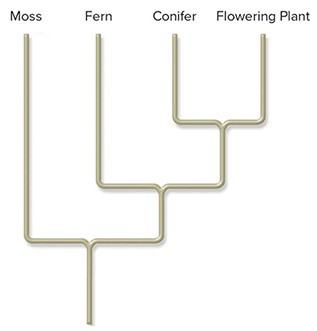Given the following cladogram and list of characteristics: ©2020 McGraw-Hill Education MossFernConiferFlowering PlantChlorophyll a & bYesYesYesYesVascular tissueNoYesYesYesSeedsNoNoYesYesFlowersNoNoNoYesBased on what you know about the principle of parsimony, which of the following is most likely a symplesiomorphy of mosses, ferns, conifers, and flowering plants?
©2020 McGraw-Hill Education MossFernConiferFlowering PlantChlorophyll a & bYesYesYesYesVascular tissueNoYesYesYesSeedsNoNoYesYesFlowersNoNoNoYesBased on what you know about the principle of parsimony, which of the following is most likely a symplesiomorphy of mosses, ferns, conifers, and flowering plants?
A. Vascular tissue.
B. Chlorophylls a and b
C. Flowers.
D. Seeds.
E. Both chlorophylls a and b and seeds.
Answer: B
You might also like to view...
The photic zone in aquatic environments is typically about how deep?
A. 10 m B. 50 m C. 100 m D. 500 m E. 1000 m
The taxon shown here with the greatest number of
named species is a. vertebrates. b. insects. c. mollusks. d. plants. e. fungi.
A scientist traveling on a boat from Alaska to Antarctica took daily measurements of atmospheric pressure. At which latitudes were the lowest pressures found?
A) polar (~90°) and subpolar (~60°) latitudes B) subpolar (~60°) and subtropical (~30°) latitudes C) subpolar (~60°) and tropical (~0°) latitudes D) subtropical (~30°) and tropical (~0°) latitudes
Which chamber of the heart does the blood first enter when it returns from the pulmonary circuit?
a. the left ventricle b. the right ventricle c. the right atrium d. the left atrium